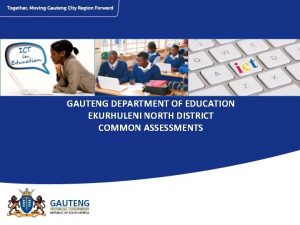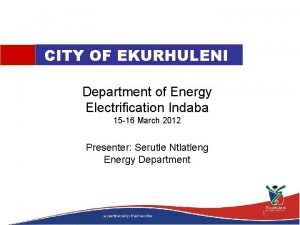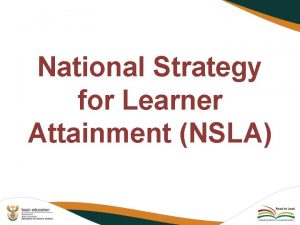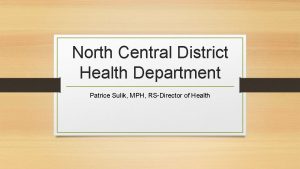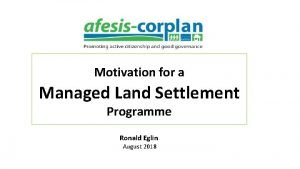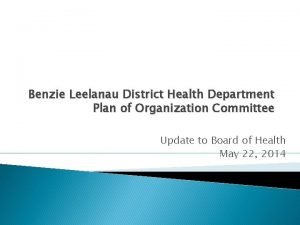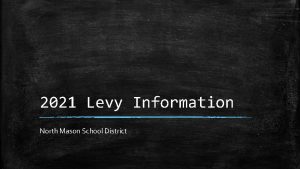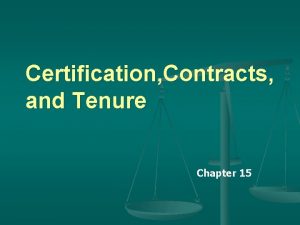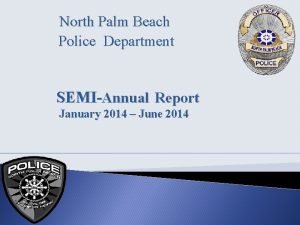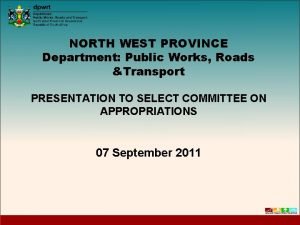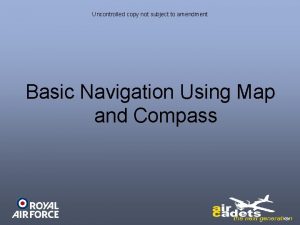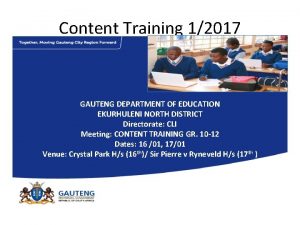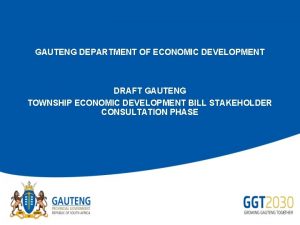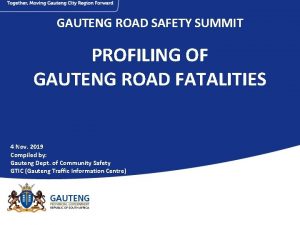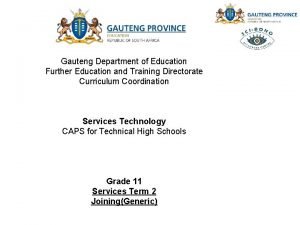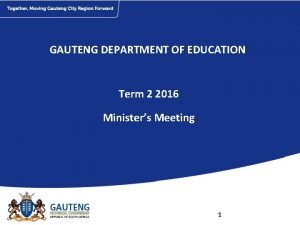GAUTENG DEPARTMENT OF EDUCATION EKURHULENI NORTH DISTRICT COMMON




















- Slides: 20

GAUTENG DEPARTMENT OF EDUCATION EKURHULENI NORTH DISTRICT COMMON ASSESSMENTS


GDE VISION AND MISSION Vision Every learner feels valued and inspired in our innovative education system Mission We are committed to provide functional and modern schools that enable quality teaching and learning to protect and promote the right of every learner to quality, equitable and relevant education. Values (L-Impact) Learner Focused Integrity Motivated Passionate Accountable Committed Truthful

CONTEXT AND VISION GDE’S 10 PILLARS FOR EDUCATION TRANSFORMATION GDE’s 10 pillars for education transformation 1. Curriculum and Assessment Development 2. Teacher Provision and Support 3. Leadership and Management 4. Infrastructure Development and maintenance 5. Planning, finance and resourcing 6. ICT in Education 7. Social Cohesion 8. School functionality including community Involvement 9. Skills Development 10. Access to quality Early Child Development (ECD) SOURCE: GDE Budget Speech 2014 and GDE 5 -Year Plan Vision and Mission Vision Every learner feels valued and inspired in our innovative education system Mission We are committed to provide functional and modern schools that enable quality teaching and learning to protect and promote the right of every learner to quality, equitable and relevant education.


VIEW OF COMMON ASSESSMENTS

CONTRIBUTING FACTORS 1. TIMSS 2011 – Grade 9 results in Maths and Science 2. ANA – 2012 – Grade 6 and 9 Maths results 3. Grade 12 average pass percentage in Maths and Physical Science 4. Average pass % at EN in 2012 Grade 8 Grade 9 ANA Maths Natural science / Physical science 53 54 15 52 56 5. Many learners in grade 11 changing from Maths to Maths literacy and changing from Physical science to other subjects

AIMS OF IMPLEMENTING COMMON ASSESSMENTS Common assessments implemented with the aim of : - Exposing teachers to what national experts considered as best practise. - Ensuring that examinations are on the correct standard with the correct cognitive levels - Determining the underlying causes of the poor results in TIMSS and ANA. - Implementing intervention strategies to improve teaching and learning at schools.

IMPLEMENTATION OF COMMON ASSESSMENTS • • Common assessments were implemented in 2013 ( Grade 9 learners continuing with provincial papers and gr 10 and 11 with national papers. Districts are not part of the provincial and national process of setting the papers). All formal assessments were compiled by teachers under the guidance of district subject advisors. Question papers are moderated by moderators and subject advisors. It is then proof read and translated into Afrikaans, which is also then proof read. Assessments adhere to the content area and cognitive level weightings as indicated in the CAPS document for Mathematics and Science. All schools are welcome to participate in the district common assessments (approximately 90% of schools). Learner scripts are moderated and results are analysed by subject advisors. The District Director advocated for the implementation of the common assessments to all stakeholders at different platforms and in 2014.

FINDINGS Findings are based on analysis of learner scripts, school visits and discussions with SMT and educators of schools. 1. 2. 3. 4. 5. Learners perform poorly in common assessments for both maths and science. Schools are not coping with syllabus coverage. Activities completed in class focus on knowledge and routine procedures. Learners struggle with terms and concepts in formal assessment. Schools that chose to administer their own assessments were found lacking in the following aspects: - Adherence to Caps requirement - ATP completion - School based moderation - Quality of questions 8. Analysis of learner scripts and reports from educators enable subject advisors to identify problematic topics / aspects for developmental purposes, as all schools are required to do diagnostic and statistical analysis.

CONTENT ASPECTS : MATHEMATICS At schools with poor results: Examples not done with learners. Mathematics terms and concepts are mentioned but there is no evidence in the learners books of them being taught. Insufficient activities provided per topic. Only textbook activities evidenced. Learners struggle as mathematical operations become more abstract and complex

CONTENT ASPECTS : MATHEMATICS Topic Algebraic expressions Algebraic equations Common fractions Aspects Learners struggle with the understanding and interpretation of an algebraic expression. They struggle with the meaning of simplify. Learners regard unlike terms as the same object. Learners do not regard factorisation as another strategy of constructing an equivalent expression. Learners struggle with the algebraic terms. Learners do not understand the meaning of the equal sign. Learners rely mostly on procedural knowledge to solve equations. Learners lack conceptual understanding. Learners tend to compare the numerators and denominators of fractions, with no common components, separately resulting in incorrect representations of the magnitude of the fractions. Addition and subtraction of fractions with different denominators poses a challenge. Learners fail to reach simplified, which mainly involve the use of HCF and fail to get the LCD. Calculations of mixed numbers

CONTENT ASPECTS : MATHEMATICS Topic Aspects Learners struggle with describing and justifying general rules. Numeric and geometric patterns Functions and relationships Interpreting and justifying of rules presented by formulae and number sentences Geometry Learners struggle to solve simple geometric problems using known properties of shapes. Justifying statements and reasons for informal and formal proofs.

CONTENT ASPECTS : SCIENCE 1. Scientific terms and definitions are not done formally. 2. Lack high level thinking skills that require learners to solve problems , think critically , evaluate , analyse and interpret data. 3. Practical activities not done due to lack of resources, teachers rely mainly on theory and textbook information. 4. Project tasks not properly done in most schools.

CONTENT ASPECTS : SCIENCE Strands Aspects Life and Living Matter and Materials Learners struggle with interaction and interdependence within the environment, differences between plant and animal cells etc. Particle model of matter, chemical reactions Planet Earth and beyond Historical development of astronomy, beyond the solar system, birth, life and death of stars. Energy and Change Potential and kinetic energy, series and parallel circuits, visible light

IMPROVEMENT STRATEGIES 1. PLC compiled formal assessments. Lead teachers from different clusters assist in compiling and quality assuring formal common district assessments. To ensure that familiar contexts are addressed. 2. Revision and intervention worksheets addressing questions of different cognitive levels are compiled and provided to schools. Action verbs were given to schools to be used in all subjects. 3. Keywords and formal terms are included in lesson plans. 4. The structure of the lesson requires the lesson to begin with examples. 5. For each topic, schools must do an informal assessment (based on past question papers) for diagnostic and intervention purposes. 6. Additional resources such as previous exam question papers , question banks and study guides developed by PLCs and district advisors are compiled and provided to schools. 7. Frequent monitoring and support provided to schools by Subject advisors. 8. Intervention and support classes are included in formal time tables. 9. Tracking of progress.

IMPROVEMENT STRATEGIES 8. Content training for educators takes place every term. 9. HOD trainings every term focus on roles and responsibilities. 10. PLC meetings take place 3 times per term focusing on content training and challenges in teaching. 11. Educators who are struggling with content are paired. 12. Trainings on setting of question papers are done for schools that are setting their own question papers. 13. All question papers are moderated at district level. 14. Attendance of training and meetings are monitored to ensure that educators who are struggling are in attendance. 15. Schools that are behind with syllabus coverage are assisted in compiling and implementing effective catch up plans. 16. FET SSIP classes are held on Saturdays at schools. Subject advisor also teach. 17. SSIP classes for grade 9 are held on Saturdays in Tembisa and Daveyton.

NOTED IMPROVEMENTS 1. Number of schools writing the common district papers have improved. 92% of our schools are writing the district paper. 2. The structure of teaching and learning has improved at schools. 3. More schools are completing syllabus as per the ATP. 4. The standard of activities given to learners have improved in quality and quantity. 5. Intervention and support is evident at schools. 6. More educators are attending trainings and workshops. 7. Evidence of HODs quality assuring school set assessments. 8. School set question papers adhere to specified requirements as outlined in the CAPS document. 9. Slight improvement to the average pass percentage. 10. Informal tasks at schools are now compiled with the aim of improving the formal assessments. 11. Informal tests are compiled for each topic and administered.

CHALLENGES 1. 2. 3. 4. 5. More work – effective planning and preparation. Overwhelmed HODs and overloaded teachers. Overcrowding in classrooms. Lack of subject specialists – especially in grade 7. Developed grade 8 and 9 educators migrating to FET.

THANK YOU
 Gde vision and mission 2021
Gde vision and mission 2021 Gde vision and mission
Gde vision and mission Sa-sams marksheets 2020
Sa-sams marksheets 2020 Ekurhuleni energy department
Ekurhuleni energy department Learner attainment
Learner attainment North central district health department ct
North central district health department ct North suburban special education district
North suburban special education district Ekurhuleni organogram
Ekurhuleni organogram Webdhis kzn login
Webdhis kzn login Sapa gauteng
Sapa gauteng Gauteng rapid land release programme
Gauteng rapid land release programme Benzie-leelanau county health department
Benzie-leelanau county health department North mason school levy
North mason school levy Toney v. fairbanks north star borough school district
Toney v. fairbanks north star borough school district Blood type map
Blood type map Dnv geoweb property viewer
Dnv geoweb property viewer North palm beach police
North palm beach police Department of public works and roads rustenburg
Department of public works and roads rustenburg North vancouver city fire department
North vancouver city fire department True north vs magnetic north
True north vs magnetic north North east and north cumbria integrated care system
North east and north cumbria integrated care system

